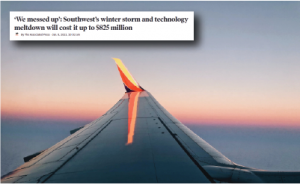“Remember that Christmas ruined by Southwest Airlines?” Over 2 million affected passengers will be recounting this story after the service meltdown involving 17,000 canceled flights and 10 days of complete mayhem. These customers will be telling their horror stories of ruined holiday travel for many years.

The Southwest Airlines meltdown was caused by a series of cascading failures – one bad thing led to something worse, and it all snowballed into a complete disaster. Trouble began in Denver where frigid temps caused issues with ramp agents (responsible for de-icing planes and loading baggage, etc.). Employees faced strict regulations and termination warnings if they called out without a doctor’s note. It’s reported that hundreds of ramp agents quit on the spot, leaving Southwest with essential aircraft tasks undone.
Service shut down in Denver, then Dallas, St. Louis, Nashville, and Chicago. The chaos overwhelmed their IT systems and software. Southwest Airlines had no idea where their crews and pilots were to try to untangle the mess. Systems grinded to a halt and passengers and crews were stranded.
President of the Southwest Airlines Pilots Association, Casey Murray, said the service meltdown was avoidable. He shared with multiple news outlets that unions and experts had warned Southwest Airlines executives about problems with their IT systems for crew scheduling. Their systems broke down during a smaller service crisis in October 2021. This IT systems failure served as a warning of problems to come, but leadership chose to ignore the failure and to not make necessary improvements.
The worst part of this entire fiasco is that it was entirely preventable! Leadership knew about the issues and knew how to make the fixes necessary. They chose not to. They chose to ignore experts’ advice to invest in a key component of their business.
Now they’re facing losses over $800 million and millions of customers lost. Their reputation is forever damaged, and they’ve issued formal apologies for their negligence. The federal government is investigating them, and the saga will go on for a long time.
A Losing Gamble
Southwest executives took a huge gamble when they ignored expert advice to upgrade their IT systems. We’ve all put off things that we know are important to do. We’ve all ignored expert advice and recommendations for some reason or another. These are all gambles and risks we take with our own lives. Business executives and business owners take similar gambles all the time.
What most people don’t realize is that small and medium businesses routinely gamble with their cybersecurity. A business is only one data breach or click on an email phishing link away from a complete cybersecurity meltdown.
Here’s a main difference between your business and a huge organization like Southwest Airlines: You’re not too small to get hacked and face a meltdown, but you’re too small to be featured on the news. I’ve heard stories of businesses facing a cybersecurity meltdown and never recovering. It’s very scary, and I will keep warning people again and again.
You can’t say you haven’t been warned. There are cybersecurity warnings everywhere for small and medium businesses. It’s a topic I constantly preach about with my own clients. I share relentlessly about this topic in our marketing and outreach efforts. Business leaders and government organizations and news outlets share warning after warning to take this topic seriously.
The most important step in protecting your business from a meltdown is to get an idea where you’re at right now with cybersecurity for your organization. Start with a cybersecurity risk assessment for your network and IT systems. Then train your entire organization with a cybersecurity awareness course. An email SPAM phishing test can also give you real data as to who poses the greatest risk for your organization.
The idea is to protect vulnerabilities in all areas of your business and proactively invest in cyber protections for your organization. Southwest Airlines didn’t take proactive measures to upgrade their IT systems and faced the consequences. The cost of upgrading their IT systems would’ve been cheaper than the $800+ million they lost during their services meltdown.





